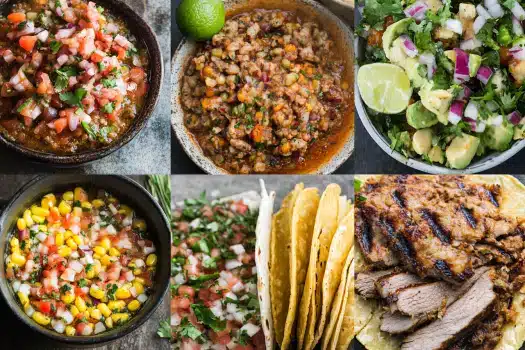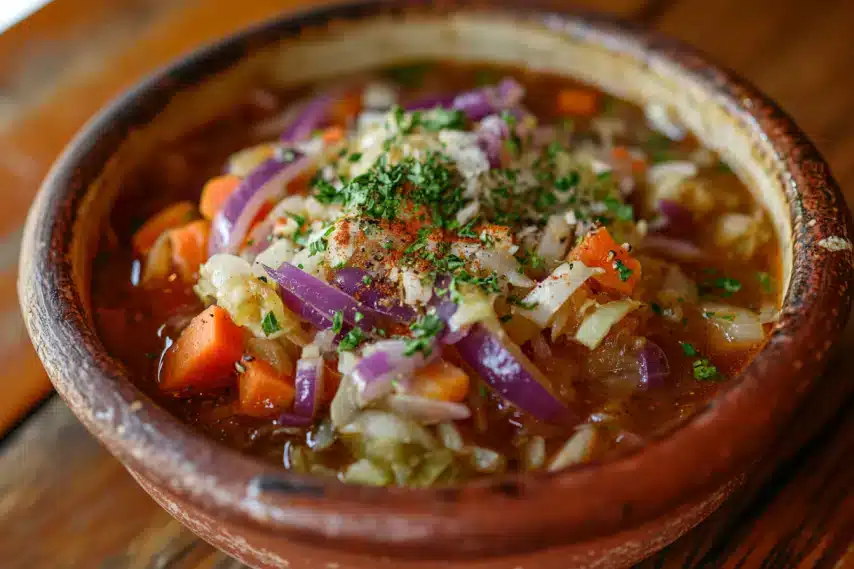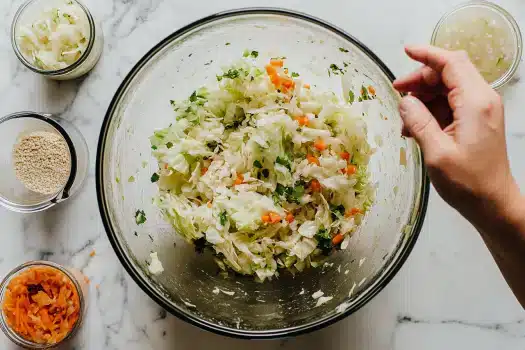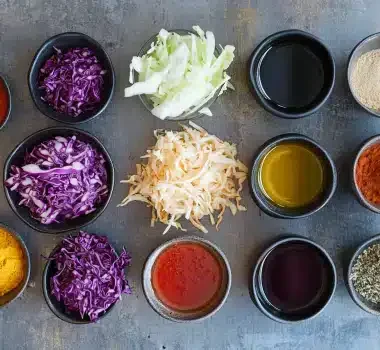Have you ever experienced the tangy zest of cortido? This vibrant and versatile pickled cabbage is a cornerstone of Central American cuisine, adding a delightful crunch and a burst of flavor to countless dishes. In this guide, we’ll explore everything you need to know about cortido, from its cultural origins and key ingredients to how to make it at home and all the ways it can be enjoyed. Whether you’re already a fan or new to this cabbage relish, get ready to discover cortido’s delightful world. This detailed guide will walk you through everything about this Central American slaw.
What Exactly is Cortido?
Before we delve into the delicious details, let’s answer the basic question, “What is cortido?”. This cabbage recipe is more than just a side dish; it’s a fundamental element in Central American cooking, bringing its own unique character to every meal. Understanding its core aspects is essential to appreciating its value.
Defining Cortido
Cortido is a type of pickled cabbage or coleslaw, often found in the cuisines of Central American countries, particularly El Salvador. It’s prepared by fermenting shredded cabbage with a mix of vinegar, onions, carrots, and various spices. This mixture of vegetables in a pickling brine gives it its distinctive tangy and slightly spicy flavor. It serves as both a condiment and side dish, adding a refreshing contrast to rich or savory meals. Cortido is known for its versatility, finding its way onto tables from simple, everyday meals to celebratory occasions. While you will find variations throughout the region, it’s always prepared in a unique style, and represents a distinctive piece of Central American culture.
Key Ingredients in Cortido
The primary ingredient of cortido is, of course, cabbage. This often comes shredded, so as to better absorb the pickling brine. Carrots and onions are also added, giving additional flavors and textures. Vinegar, usually white or apple cider vinegar, serves as the main pickling agent and is always a must. A mixture of spices is added depending on the region and preferences, which might include oregano, salt, and pepper. While these are the common ingredients, some will add other vegetables to the mix, which always make cortido unique. It is this mix of pickled vegetables and spices that makes the core of this popular Central American slaw.
The Origins and Cultural Significance of Cortido
Cortido isn’t just a random combination of pickled vegetables; it has deep roots in the history and culture of Central America. It’s a food that carries the legacy of generations, and plays a crucial part in the region’s gastronomy.
The Historical Roots of Cortido
The practice of pickling goes far back in time, and its presence in Central America has a rich history. Cortido evolved from the need to preserve vegetables and has become a staple across multiple countries in the region. Over time, the basic pickling techniques have blended with local ingredients and culinary preferences, giving rise to the version of cortido we know today. This fermented food is an example of how resourceful people can be, and how delicious can be the result.
Cortido in Central American Cuisine
In Central American cuisine, cortido is more than just a side dish; it’s an essential component of many meals. You will find it being used as a condiment, a topping, and a flavorful side. It is an integral part of the local culinary landscape. Whether you go to family homes or street food vendors, you will see it everywhere. Cortido is found in almost every family kitchen and it is an important piece of their daily lives. It represents a strong link to local tradition and flavors.
How to Make Cortido at Home: A Step-by-Step Guide

Now that you understand what cortido is and its cultural importance, it’s time to learn how to make it yourself. Making cortido at home is not as difficult as it might seem, and it will give you great control over the flavors.
Gathering Your Ingredients
To make cortido you’ll need a few fresh ingredients. The essential ones are finely shredded green cabbage, shredded carrots, and sliced onions. You also need vinegar, which can be white or apple cider vinegar. Spices are next, so get ready with your oregano, salt, pepper, and sometimes chili flakes if you prefer it spicy. Ensure that your vegetables are fresh for the best results. This is the first step to making delicious homemade pickle.
The Preparation Process
The preparation is straightforward. In a large bowl, combine the shredded cabbage, carrots, and sliced onions. In a separate container mix the vinegar with the spices. Pour the brine over the vegetables, ensuring everything is well mixed and distributed. Use your hands to gently massage the brine into the vegetables. This is important for the cabbage to release water and start the pickling process. This makes sure that the pickled vegetables are flavorful.
Fermentation and Storage
Once everything is mixed, transfer it to a clean jar or container and press it down to remove air pockets. Allow the cortido to ferment at room temperature for 1 to 3 days, depending on how tangy you want it. The longer it ferments the more tangy it gets. After that, you can store it in the refrigerator for up to two weeks. Be sure to refrigerate it to slow the fermentation and preserve the quality of the cortido.
Cortido Variations: Regional and Personal Twists

While the basic cortido recipe remains consistent, regional differences and personal preferences create unique variations. This section will explore the many ways this pickled cabbage is adapted and enjoyed.
Regional Differences in Cortido Recipes
Cortido varies across Central America, from region to region. In El Salvador, it’s often made with the addition of red onions and oregano. In other countries, you may find versions that incorporate different spices or even other vegetables such as cauliflower. These regional twists often reflect locally available ingredients and flavors that have evolved over generations. This is what makes each cortido unique and delicious.
Customizing Cortido to Your Liking
You can easily customize cortido to your own taste. If you prefer it spicy, you can add more chili flakes or finely chopped jalapeños. For a sweeter flavor, you can add a pinch of sugar or add some other sweet vegetables. You can add a different herb in order to have more fragrance to the cortido. These small adjustments can transform the recipe to perfectly suit your palate and preferences. It is in these personal touches that you can create something unique with this cabbage slaw.
Exploring Alternative Pickling Brines
The pickling brine also provides room for experimentation. While white vinegar is a classic choice, you can use apple cider vinegar for a milder flavor. You might also experiment with different proportions of salt or sugar to find the best balance for your cabbage relish. Trying different brines will help you discover a profile that suits your personal taste.
Serving Suggestions and Culinary Uses of Cortido
The versatility of cortido is one of its greatest strengths. It can be served in so many ways, and enhance dishes to bring a unique flavor and texture to various meals. It is a great meal accompaniment and a very versatile side dish.
Cortido as a Condiment and Topping
Cortido is often used as a condiment or topping to add a tangy and crunchy element to various dishes. It complements rich and savory meals, offering a refreshing contrast. It is usually served on the side or added on top to add some extra zest. This is a simple but efficient way to use this tangy condiment and to add flavor to any dish.
Popular Dishes Served with Cortido
Cortido traditionally accompanies dishes like pupusas, which are thick griddle cakes, and tacos, adding a crunchy and tangy bite. Its refreshing flavor cuts through the richness of the meat. People often pair it with grilled meats and other savory dishes, making it a perfect complement. These examples show how important cortido is in Central American meals.
Creative Culinary Applications
Beyond traditional uses, you can use cortido in a lot of creative ways. Add it to salads for an extra layer of flavor, or use it as a topping for sandwiches. Its unique taste makes it a great addition to many non-traditional dishes. Its versatility makes this cabbage salad a great companion for almost any meal.
The Health Benefits of Cortido
Apart from its great taste, cortido also offers a lot of health benefits. Its ingredients and fermentation process make it a nutritious food, and contribute to overall health.
Nutritional Value of Cortido
Cortido is rich in vitamins and minerals from the fresh vegetables it contains. Cabbage is a great source of vitamin C and vitamin K, and carrots are well known for their vitamin A content. The vegetables also provide dietary fiber. The pickled vegetables also have a good amount of antioxidants. This simple side dish can be a great addition to a healthy diet.
Probiotics and Gut Health
As a fermented food, cortido is a great source of probiotics that help gut health. Probiotics are beneficial bacteria that contribute to a healthy gut biome. They aid in digestion and can boost the immune system. Adding foods like cortido into your diet can improve your gut health and help your overall well-being. These probiotic foods help in the digestive process.
Potential Health Considerations
Now, while cortido definitely has a lot of good things going for it health-wise, it’s also wise to keep a few potential downsides in mind. Because it’s got salt in it, and it’s pickled, cortido can have a high sodium content. Also, since it’s a fermented food, it might cause some tummy troubles for folks who are more sensitive to that sort of thing. So, for those reasons, it’s best to enjoy cortido in moderation as part of a healthy, balanced diet.
Where to Find Cortido?
If you’re looking for cortido, you have several options. You can choose between making it yourself, or find it in the market.
Making Cortido at Home vs. Buying It
Making cortido at home is a great way to have control over the flavors, quality and ingredients, and it is generally cheaper. It is not so difficult to make, so you can definitely try at home and then you can adjust it to your own taste. On the other hand, if you don’t have the time or the ingredients, buying it might be a more practical approach. Both are good options, and it depends on your needs and preferences.
Exploring Local Markets and Latin Stores
If you’re thinking about buying cortido, then checking out your local markets or Latin stores is a great idea. These places usually have fresh cortido available, and they often carry all the ingredients you’d need to make it at home, too, if you change your mind. The cortido you find in these kinds of stores is often made using traditional recipes, so you’re likely to get those truly authentic flavors you’re after. Plus, you’ll have a much more immersive, real-deal kind of experience when you visit these places.
How to Store Cortido
Once you buy or make cortido, be sure to store it correctly. When homemade, always transfer it to an airtight container. Always store cortido in the refrigerator. If properly stored, cortido can last for a couple of weeks. Proper storage will preserve its quality, flavor, and texture. You can find other techniques on easy pickling recipes on sublimecake and simplyrecipes.
Cortido FAQs
To wrap up, let’s explore some frequently asked questions about cortido. These answers will cover a few doubts you might have about this savory side.
Common Questions About Cortido
- FAQ 1: What is the primary flavor profile of cortido?
- FAQ 2: Can cortido be made without vinegar?
- Vinegar is the base of the pickling process, so it is not recommended to omit it.
- FAQ 3: How long does homemade cortido last?
- If stored properly in the fridge, it can last up to two weeks.
- FAQ 4: Is cortido spicy?
- It has a mild spice level, but you can add peppers for more heat.
- FAQ 5: What dishes are traditionally served with cortido?
- It’s often served with pupusas, tacos, grilled meats, and various Central American dishes.
- FAQ 6: Can cortido be made vegan?
- Yes, it is naturally vegan if you use plant-based ingredients.
- FAQ 7: Is cortido the same as sauerkraut?
Conclusion
Cortido is a testament to the rich culinary traditions of Central America. Its tangy flavor and crunchy texture make it an essential part of the region’s food culture. Whether you make it at home, or enjoy it in your local restaurant, it is an experience that is worth exploring. The unique qualities and flavor, ensure its position in traditional cuisine, as a timeless cabbage relish.






